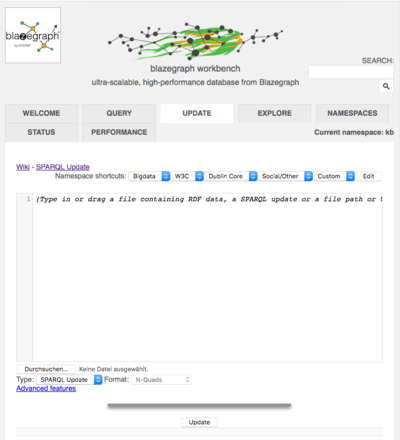Difference between revisions of "SPARQL"
| Line 74: | Line 74: | ||
</source> | </source> | ||
=== The Blazegraph Web UI === | === The Blazegraph Web UI === | ||
| + | [[File:blazegraph1.png|400px|left]] | ||
The Web-UI shows the Tabs: | The Web-UI shows the Tabs: | ||
# WELCOME | # WELCOME | ||
| Line 82: | Line 83: | ||
# STATUS | # STATUS | ||
# PERFORMANCE | # PERFORMANCE | ||
| − | + | ||
Let's start with the UPDATE tab to load some sample data. | Let's start with the UPDATE tab to load some sample data. | ||
Revision as of 13:21, 4 January 2018
What is SPARQL
SPARQL is a query language for semantic databases using the Resource Description Framework (RDF) format
Tutorial
There are quite a few tutorials out there for SPARQL e.g.
This tutorial is for people which are new to semantic concepts but would like to use an example with a fair amount of data but not too much of complexity in the structure of the data.
Semantic Concepts
Personally I learned Semantic Concepts using Semantic MediaWiki see
When using SPARQL a tutorial needs to get a slightly different touch, so for those who know the talk above I'll explain some key concepts based on an example using:
- Countries
- Towns
- Municipal Units
Triples
A semantic statement has the form
<subject> <predicate> <object>
e.g.
Dubai is-located-in AE
is such a semantic statement which is also called a Triple.
The natural language statement "Dubai is located in United Arab Emirates" is purposely slightly modified to a more "computer-ready" form. The predicate has been written as is-located-in to make it a proper Identifier. And the country-name "United Arab Emirates" has been replaced by its two letter United Nations Location Code AE.
TripleStore
A Triplestore is a database that can store and query triples. In fact for educational purposes I have written a simple Triplestore myself:
For that simple triplestore the triples are supplied in Simple Data Interchange Format. Again that format is mostly for educational purposes although it can also be used for small usecases with just a few thousand triples. Please also note that there is no SPARQL support in that project.
For more than a non-educational use a Triplestore is needed that can handle larger amounts of data and support SPARQL. The Wikipedia List of Subject-Predicate-Object Databases shows you some options. For this tutorial we'll use Blazegraph.
Setting up the Blazegraph Triple Store

You need Java to be installed on you machine.
Download the blazegraph.jar file from https://www.blazegraph.com/download/ and start it with
java -jar blazegraph.jar
In fact it's better if you start the jar file with an option to allow bigger xml files to be handled:
java -Djdk.xml.entityExpansionLimit=0 -jar blazegraph.jar
otherwise you might run into the error:
org.openrdf.rio.RDFParseException: JAXP00010001: The parser has encountered more than "64000" entity expansions in this document; this is the limit imposed by the JDK
you should see
Welcome to the Blazegraph(tm) Database. Go to http://localhost:9999/blazegraph/ to get started.
And you might want to do just that and click that link.
Where Blazegraph stores it's data
The default setting for Blazegraphs journal file is to use blazegraph.jnl in the directory where you started the jar file. On my Mac OS Laptop the initial file size is some 200 MBytes.
ls -l blazegraph.jnl
-rw-r--r-- 1 wf staff 209715200 4 Jan 11:50 blazegraph.jnl
The Blazegraph Web UI
The Web-UI shows the Tabs:
- WELCOME
- QUERY
- UPDATE
- EXPLORE
- NAMESPACES
- STATUS
- PERFORMANCE
Let's start with the UPDATE tab to load some sample data.
The sample Data
The human readable form of some of our sample data and their description is available at:
- https://en.wikipedia.org/wiki/UN/LOCODE
- http://www.unece.org/cefact/locode/service/location
- https://www.unece.org/fileadmin/DAM/cefact/locode/ae.htm
